A lot of trampolinists who come into trampoline from other
sports will already have imbalances due to the physical demands of the previous
sport. Please read my article labeled
“FMS Potentially Pointless” if you have not already to help get a better
understanding of muscle imbalances. “http://www.gregroetrampoline.ca/search?q=FMS+
For example a trampolinist who was a former gymnast tend to
have tight hip flexors because of all the leg lifts and hip flexor action that
is required by the sport. Generally hip flexors are not stretched out enough
and that is why many female gymnasts stick their rear-ends out during normal
gate. More on this example later. A
trampolinist who was a former hockey player may have tight adductors in the
legs. Everyone has imbalances and they are not bad, however the athlete needs
to be imbalanced in a way that is appropriate to their sport. Let’s start with
some major muscles that tend to be tight or under used which cause imbalances
that will negatively affect a trampolinist’s performance.
VALGUS KNEES:
This is
when the athlete’s knees turn inward and sometimes it causes the rest of the
lower leg to rotate inwards as well as you can see a bit in the picture below. Usually
it is more evident during a squat and you can really see the knees turn in the
lower the athlete goes into the squat.

Tight Muscles:
Hip Adductors: Stretch:


Hip Flexors: Stretch:
Affected Muscles:
Peroneals:

Weak Muscles:
Iliotibial Band
(IT Band)/Tensor Fascia Latea: Exercise:
Hip External Rotators Exercise:

Gluteus
Maximus: Exercise:

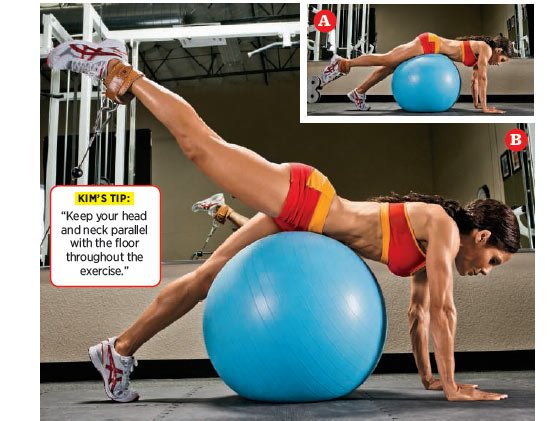
Valgus Knees is very common and can easily be fixed by anyone who can spot it. I admit that before I started doing exercise science I had a bad case of valgus knees due to my tight hip flexors. Valgus knees is easy to get even without imbalances because it is naturally easier to turn the knees in during exercises such as squats. Unless the athlete is taught to force the knees outwards then he or she will naturally let the knees fall into the midline of the body.
Above are the tight muscles, weak muscles and affected muscles of valgus knees. it is as easy as stretching and strengthening the targeted muscles that I list. No magic tricks folks, just time and effort. There are national team members that have this condition and have had serious injuries due to it. This is not to be taken as a joke, it is a simple reminder of how easy it is to forget to train in a correct fashion. Any athlete who knows what he or she is doing would (in my opinion ) be foolish to try and say they never forget about basic weight lifting principals. You constantly have to remind yourself and go through the exercises properly, on camera and evaluate your technique, not just how much wight you lift.
In the first section of this series I touched on the duration, intensity blah blah blah of stretching so I will not repeat myself here. I will mention a few key notes that I think are worth explaining.
In Valgus knee rotation the outside of the legs and glutes tend to be flexible and elongated compared to the inside of the leg where you find the adductors. The inside of the legs tend to be very stiff and tight and over worked. This could eb for lots of reasons, normally being the fact that the athlete does not stretch and strengthen appropriate muscles in the right ratios. If you see the knees go in as a coach then put your hands on the outside of the knees during squats or lunges to emphasize the direction in which the knees should be facing.

This is extreme but you can fully see the knee pointing inwards here.
**** I mentioned above that during a seated leg extension, if you were to externally rotate the knees you would put a greater emphasis on the VMO. This is true however the exact amounts of emphasis are debatable. You should get a bit of extra strengthening in the VMO however it will not be a highly noticeable change. Simply by doing squats and chair sits with knees pushing outwards by mind or by force will help. You do not really need to go to crazy lengths by rotating limbs to fix valgus knees. Try it, if it works, great, if not, no biggie just grab a band and put it around your knees and externally rotate those hips.
Tight hip flexors are a huge problem in trampoline usually and this could be for a few reasons. The main one I see is that while in the air the easiest way to correct the balance issue when jumping all over the place is by bending the hips, which brings the center of gravity higher which in turn allows the athlete to regain control of their body. Oh well who cares? You bend your hips a few times, it doesn't matter. Well lets do some basic math. Say it takes about 8 prebounces to get to full height and start the routine. The first 3 04 4 usually recruit more back extensors and glutes which causes the athlete to have to use the hip flexors. Then the athlete has to then balance so lets say for each routine of 8 prebounces has 2 bounces where piking of the hips occur to balance the athlete. So far we are at 6 hip flexions just before the routine starts. Oh ye did I forget to mention the fact that every front take off requires hip flexion to push the toes forward into the bed to generate rotation forwards? Well yes it does and as you can see this will add up quite quickly. However most athlete's do not even think about it. I know I never did, I also know I rarely see any athlete's put real time into their hip flexors.
I could go on for years about the involvement of hip flexors in trampoline however let us move on to the real reason i even brought it up. If the hip flexors are tight it pulls on the inner side of the femur causing hip adduction. Then the extra stress causes the adductors to be activated at a greater intensity causing the adductors to be naturally tight. This elongates the ITB and TFL and after a month or so of this being not treated .... VIOLA VALGUS KNEES!!
Coaches do not look at the knees and fix the knees. Look past the knees and figure out why they are the way they are. Punching a bull in the face while it chases you may be fun but probably is not very affective. However, knowing how to lock the gate is.
Now that you have said that I bet all of you are thinking, or at least you should be, "what causes the hip flexors to be tight" That my friends is an article for another day. For now start with these exercises and just think about the knees and you will start seeing quick improvements.
One picture I think I should explain before moving onto the next condition is the picture of the Peroneal muscles. These are the muscles on the outside of the lower leg and cause ankle eversion and external rotation. In Valgus knees normally these muscles will tighten up due to the knees rotating inwards. This is not a big problem usually and should not even really matter to the coach at first. Fix the hip flexors and knees and the peroneals will basically fix them selves. Stretching them out by rolling the ankle will help but you do not want to stretch too much or the ankle joint will be come weaker. In Trampoline if you have a great toe point your chance for ankle injury is higher then tight ankles. Like anything there is a happy medium. It is up to the coach and athlete to decide what is more important to them.
VARUS KNEES:
This condition is the opposite of valgus knees. The knees are pointed outwards in this circumstance and the feet usually point outwards and the athlete walks like a duck.This condition is known as bowlegged. Some people try to say it is a genetic deformity but not many babies are "popped out" with bowed legs. It is how the child is brought up that will usually determine if he or she is bowlegged. A constant pull of certain muscles will bend bone after years as well as change the articulation of joints. I do not know the individual below but if I had to guess I would say that his knee joint on the lateral sides do not even touch. The lower leg is most likely relatively straight but because the knee joint is not hinged properly then it gives the illusion of curved legs.
This condition is the opposite of valgus knees. The knees are pointed outwards in this circumstance and the feet usually point outwards and the athlete walks like a duck.This condition is known as bowlegged. Some people try to say it is a genetic deformity but not many babies are "popped out" with bowed legs. It is how the child is brought up that will usually determine if he or she is bowlegged. A constant pull of certain muscles will bend bone after years as well as change the articulation of joints. I do not know the individual below but if I had to guess I would say that his knee joint on the lateral sides do not even touch. The lower leg is most likely relatively straight but because the knee joint is not hinged properly then it gives the illusion of curved legs.

Tight Muscles:
Iliotibial Band (IT Band) Stretch:
Hip External Rotators Stretch:

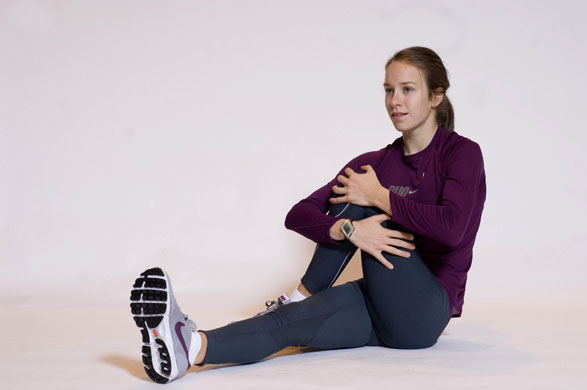
Gluteus Maximus: Stretch:

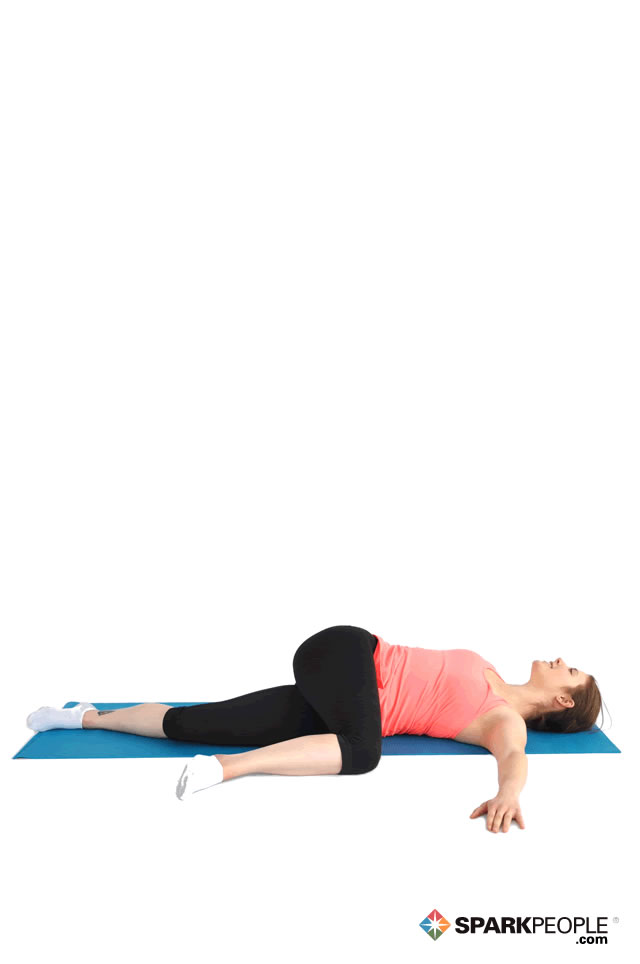
Weak Muscles:
Hip
Adductors: Exercise:
Hip Flexors: Exercise:
Blue( Psoas M)
 Red (Illiacus)Green (Rectus Femoris) (quad)
Red (Illiacus)Green (Rectus Femoris) (quad)
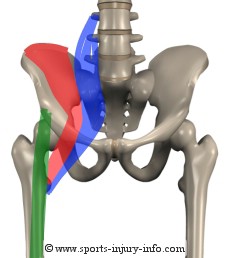
This condition is one of my pet peeves. Normally hyperextension of the knees comes form being lazy. Generally people who are overweight have this condition because they tend to lock the knees while standing and place all the pressure on the back of the knees. At first it is no big deal but then the person starts doing this over and over again and eventually the quads tighten up pulling the hip forward ( Rectus Femoris). The calves relax and the tibia shifts backwards slightly. This gives the appearance of an angle when looking from the side.

Stretches:
Quads: Hip Flexors:
Strengthen:
Hamstrings: Gastrocnemius:
Stretch the front and tighten up the back to get the knees back inline with the midpoint of the leg. This will take longer then the knee valgus or varus usually due to the fact that you will most likely forget about it in regular activities and take a step back for every few forward. This is ok and normal but try to think about it as much as possible to increase speed of recovery.
SHIN SPLINTS:
1) Deep Tissue Massage:
2) Stretch the Muscles:
Tibilais Posterior: Stretch:


Solues: Stretch:


Tibilis Anterior: Stretch:


This condition is not as common but has been more evident in the high level athlete's in trampoline from what I am told so i decided to throw it in. Fascia is the technical term for a thin sheet of tendon that helps stabilize a joint or muscle. You can think of it like a saran wrap around most major organs and muscles in the body.



There we go, covered some of the major lower extremity imbalance issues. Next in the series, we will focus on the core which will help everyone understand why some of the lower leg imbalances are even occurring, such as the hip flexors.
Thanks:)
Blue( Psoas M)
 Red (Illiacus)Green (Rectus Femoris) (quad)
Red (Illiacus)Green (Rectus Femoris) (quad) 
For Varus Knees the weak muscles and tight muscles are more or less reversed. The outside of the legs are tight including the glutes and the inside of the legs are looser and allow the knees to get pulled outwards. No magic tricks here, just follow the above simple exercises and you can easily correct the problem. Most athlete's do not have bow legged lower limbs for a few reasons.
1) usually the varus knees are prone due to up bringing and never having a professional teach you what is right from a young age. Normally these athlete's, unfortunately, get weeded out of the sport by inexperienced coaches who simply think it is not treatable or by other athlete's who make fun of the condition. Survival of the fittest is very evident in high level sport and athletes with large imbalances tend to get shown the door.
2) Not many sports require the hips to excessively rotate outwards normally so to find an athlete who has varus knees is more rare.
Some athlete's are simply not fixable by conditioning and will need surgery to fix the knee problems. This is a last resort and a long time should be spent on at least attempting to condition the right lifting mechanics.
Varus joints are more typically found in the elbow due to the fact it is more prone to movement then the knees and hips.
HYPEREXTENDED KNEES
This condition is one of my pet peeves. Normally hyperextension of the knees comes form being lazy. Generally people who are overweight have this condition because they tend to lock the knees while standing and place all the pressure on the back of the knees. At first it is no big deal but then the person starts doing this over and over again and eventually the quads tighten up pulling the hip forward ( Rectus Femoris). The calves relax and the tibia shifts backwards slightly. This gives the appearance of an angle when looking from the side.
In this picture you can see exactly what I mean. Yes this person is not fat and I picked it on purpose so that everyone can see that it is not a guarantee you are fat it is just a higher chance. This condition is not even caused by imbalances normally. Normally it is just a wrong application of force. This could be as I just mentioned, because of lazy standing mechanics or because of an impact on the front of the knees that push the tibia backwards.
To fix this it is not too difficult but will feel weird because the athlete or non athlete has to focus every minute on not straightening the legs. It becomes a habit normally and that is why it is hard to fix, just like the knee problems.
Stretches:
Quads: Hip Flexors:
Strengthen:
Hamstrings: Gastrocnemius:
Stretch the front and tighten up the back to get the knees back inline with the midpoint of the leg. This will take longer then the knee valgus or varus usually due to the fact that you will most likely forget about it in regular activities and take a step back for every few forward. This is ok and normal but try to think about it as much as possible to increase speed of recovery.
SHIN SPLINTS:
This is a very popular imbalance and should be treated with care and caution as soon as the first signs manifest to help ensure that it is not a chronic problem. Shin splints are when the front of the shins hurt an athlete and is most common in sports that use their lower legs a lot, especially jumping. This is very easy to fix and will normally get better a few a week depending how serious it is. Normally there is no long term damage and it is simply pain but does hurt of course and can make training kind of a drag if not dealt with. Two things you have to do and they are:
1) Deep Tissue Massage:
You can do this yourself by cutting your nails and digging your thumb into the affected area which is normally middle of the shins and can go towards the ankle. If it hurts alot you are doing it right probably. It is not fun and sucks!!! you do not need to get fancy, just rub the shin in little circles or up and down or even jump applying pressure ( it is not as effective usually, but depending ont he severity it may be the only thing the athlete can tolerate).
What you are doing is breaking apart all the tight muscle fibers that have attached to the bone. Once the muscle pulls on the bone the muscle says "hey if I had more fibers attached to the bone then I could pull harder" . You do not want this. You want to massage out all the "micro tears" and help flush out the build up of extra fibers and cartilage. You want the body to actually relax and stop pulling so hard on the bone because that is what is causing the pain.
2) Stretch the Muscles:
Tibilais Posterior: Stretch:


Solues: Stretch:


Tibilis Anterior: Stretch:


Stretch out these muscles every day and the constant pulling of the bone will decrease and the pain should subside. The calf muscles are very important and normally are the issue. The Gastrocnemius does NOT attach on the lower leg and normally does not affect the shin splint. With that said the Achilles Tendon is the a common point of insertion of both the Soleus and the Gastrocnemius so stretching both is a good idea in general. Tibilias Posterior and Soleus are stretched by keeping the back leg bent which will cut off the stretch to the Gastrocnemius due to the fact it originates above the knee joint. I know it sounds simple and it is so I will simply move on to the final condition of the article.
Plantar Fasciitis:
This condition is not as common but has been more evident in the high level athlete's in trampoline from what I am told so i decided to throw it in. Fascia is the technical term for a thin sheet of tendon that helps stabilize a joint or muscle. You can think of it like a saran wrap around most major organs and muscles in the body.

As you can see here the fascia goes from the Calcaneous ( heel) to the MP joints of the foot. THIS IS NOT A MUSCLE!!!!!!! Therefore you do not stretch it. If you stretch it, it will get worse and the fascia will start to weaken and maybe even tear. You can not repair cartilage or tendon. Small amounts can be fixed by the body but generally what you have is what you are given. Be careful with it. Do not stretch, just rest. Ice and heat will help keep swelling down and relax the fascia without stretching it too much. Everyone wants to grab that big to and pull but please resist the urge to do this.
Like any injury it normally happens when a dramatic change occurs in training. Easiest way to avoid this problem is by steadily increasing work loads. A lot of trampolinists complained that when they bounce on Eurobeds that they had this pain. That makes sense because Eurobeds are a lot tougher then string beds. Having trained on string for 90% of our trainings then switch to Eurobed right before a world cup does not make much sense does it? Unfortunately Eurobeds have a shorter life expectancy and are worn out after 4 or 5 months. To keep these beds new and working properly is a huge task so athlete's need to suck it up and do a lot more bounding off the toes to strengthen the muscles, tendons and fascia under the foot.


There we go, covered some of the major lower extremity imbalance issues. Next in the series, we will focus on the core which will help everyone understand why some of the lower leg imbalances are even occurring, such as the hip flexors.
Thanks:)












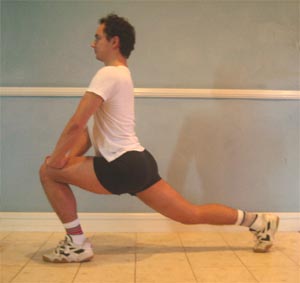

My spouse and I absolutely love your blog and find nearly all of your post’s to be precisely what I’m looking for. Would you offer guest writers to write content for you? I wouldn’t mind producing a post or elaborating on a few of the subjects you write about here. Again, awesome site! https://www.altitudetrampolineparklr.com
ReplyDelete